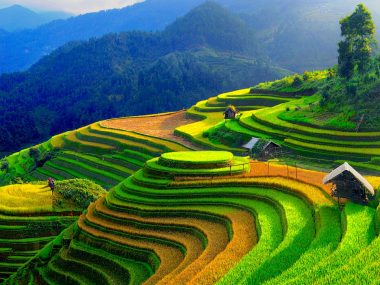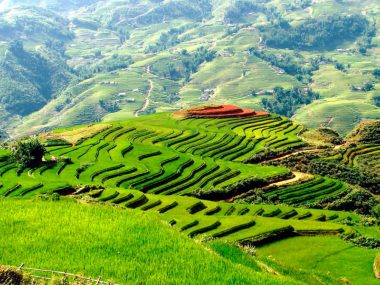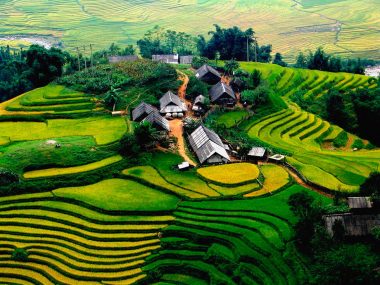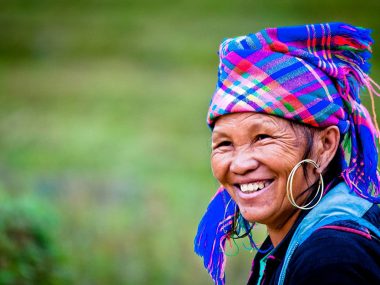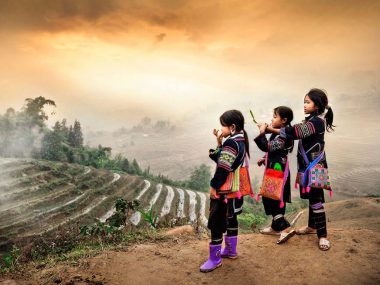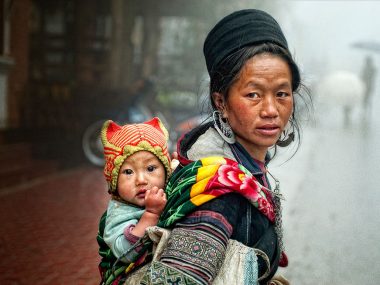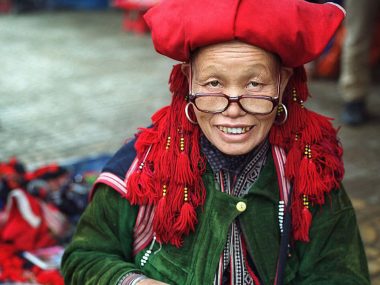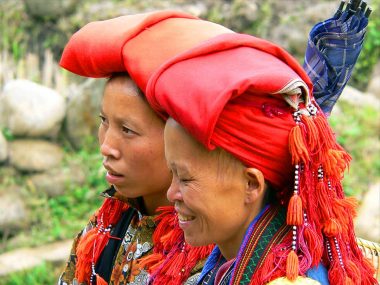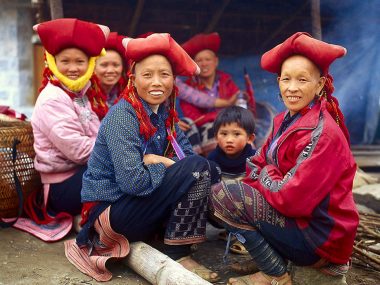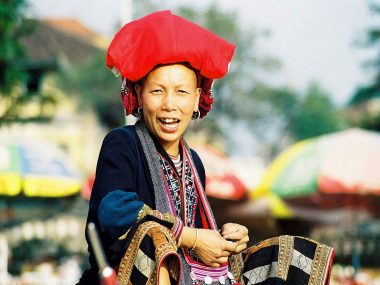Sa Pa and its neighborhood
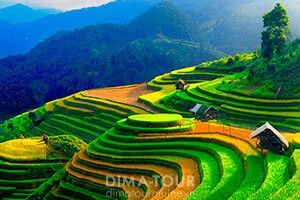
Sa Pa is unlike any other Vietnamese city. Yes, what can we say, Sa Pa is unlike any other place in the world! Sa Pa offers you, first of all, magnificent landscapes of rice terraces, which conquer even the most experienced travelers, traditional lifestyle and beautiful handicrafts of the Hmong and Zao people, and, of course, mountain waterfalls.
Table of Contents
Mountains and rice terraces
Sa Pa is surrounded by cascades of rice terraces, bathed in the sun, which create a truly stunning scenery. Rice terraces are built by farmers where the mountain slopes meet plains. Farmers cut steps in terrain in a special way to plant rice there. Rice terraces are an example of a miracle created by people and nature together. The rice, green on the slopes of Sa Pa, creates a serene and majestic views you will remember forever.
Sa Pa is located in a valley surrounded by mountain peaks. Lots of medicinal herbs, used to make medicines and tinctures by the Vietnamese, grow on these slopes. Sa Pa is also an area where cherries, peaches, plums and other fruit trees grow great. Their delicious and juicy fruits are considered the pride of Sa Pa. It is worth mentioning that these fruits are not typical for the South of Vietnam, and are considered to be a sort of delicacy.
The town of Sa Pa itself offers many hotels and guesthouses for tourists. Sa Pa has an observation deck on the radio tower, which offers stunning views of the mountains and rice terraces. Also, tourists like to visit the local market, where they can buy fruits, as well as magnificent handicrafts, traditional clothes and souvenirs.
Also local people of Sa Pa perform songs, dances and shows for tourists. There are often professional bands invited as well. Nevertheless, the music and dances they perform are traditional.
Trekking in the picturesque mountain valleys of Sa Pa, visiting local villages and rice terraces is the main purpose of all tourists who come to Sa Pa. Long hikes in the mountains are not very difficult, but still do not suit the elderly. Therefore, many tours in the surrounding area are carried out by car. Sure, the car can not go along all the trails, but such a trip will leave you with a lot to remember. The most experienced tourists who are good at driving a motorbike (moped) in difficult conditions can travel around the neighborhood using this two-wheeled motor vehicle. At the same time, it would be hard, sometimes even impossible to ride bicycle at the local mountains.
Mount Fansipan is the highest mountain peak of Sapa. Those who don’t feel like just admiring the mountain from the distance is enough can join a trekking tour from Sa Pa to the top of Fansipan. This route passes through rather harsh terrain. It can get very slippery and wet here, and as you go up, the weather may get worse. The route takes up to three days, and if you have no experience of such trips, it is better not to take this risk. We also recommended you to buy rubber boots (or even special trekking boots), raincoats and warm jackets for trekking in Sa Pa, just to be prepared if it rains.
Thac Bac Waterfall
The beautiful Thac Bac waterfall near Sa Pa is also called the Silver Waterfall. The streams of water do fall down like shimmering precious threads, and humid and clean air allows you to breathe here freely. The waterfall is so huge that it is difficult to fit it all into one photo. This natural attraction is located 12 kilometers from Sa Pa. It is better to come here in summer, when rainwater fills the rivers and makes the waterfall more powerful and magnificent. You can reach the upper rapids using the stairs, that circle the waterfall.
Hmong people
Several ethnic groups live in the vicinity of Sa Pa. The most numerous people are Hmong. They are distinguished by their clothes of different colors (black, blue, white, red, striped). Depending on the color of their clothes, the Hmong belong to different ethno-regional groups, called:
- Black Hmong (Hmoob Dub or Hmong Dou),
- Green Hmong (Moob Ntsuab or Hmong Xanh),
- White Hmong (Hmoob Dawb),
- Red Hmong (Hmong Do),
- Striped Hmong (Hmoob Txaij or Hmoob Quas Npab).
These people are very hardworking and lead an almost medieval lifestyle. The Hmong live in houses with one common room and a room for cooking (kitchen with fireplace). However, with the development of tourism, many Hmong have reoriented their lives in this direction: they produce and sell souvenirs or host tourists in their homes.
The Hmong often try to build their villages away from other people and higher into the mountains. Nevertheless, the Hmong are very friendly and hospitable people.
The Hmong have their own looms of the original design (one end of the fabric is attached to the machine, the other to the back of the weaver, who chooses the tension of the linen thread using her back). Children are always those getting the most colorful Hmong costumes. Hmong clothes are embroidered by hand with gorgeous traditional ornament, or decorated with appliqués. The Hmong make these patterned using a method very similar to batik. They cover a part of the fabric with wax, so it wouldn’t get colored, and then apply dye.
The Hmong live not only in Vietnam in the Sa Pa region, but also in China, Laos and Thailand. Many Hmong also live in Myanmar, some have emigrated to the United States. In general, this nation consists of about 9 million people, most of whom live in China (7.4 million). In Vietnam, there are about 780 thousand Hmong.
Many tribes of the Hmong speak the Miao language and various dialects of the Hmong language. Miao tribes traditionally settled in the territory of modern China (in the area of the Yellow River), but they were persecuted in the 17-19 centuries, that led to mass migrations towards South.
Chiao Lai Village
In this village near Sa Pa Hmong people live their everyday life, that’s way different from the lifestyle of modern people. The villagers honor traditions and do not allow too many elements of civilization here. Here you can buy souvenirs at affordable prices. The trade is mainly carried out by local women. Men do not like to make contact with foreigners. In addition to products and fabrics painted with natural ingredients, locals offer tourists to buy jewelry made of metal.
Ta Van Village
You can go to the Ta Van Village tour from Sa Pa, following the road along the rice fields. Representatives of Hmong, as well as another tribe, Jay, live in this settlement. Residents of a village near the Chinese border have brought many Chinese traditions into their lives. They accept tourists visiting their homes, so here you can see the life of the villagers, as well as try the traditional local cuisine.
Cat Cat Village
The Black Hmong live in Cat Cat village. Their life is different from the urban in its regularity and tranquility. They make their own clothes from beginning to end: spin, weave and color with natural dyes. Tourists often visit this village, and the Hmong are used to them, they are not opposed to newcomers observing their daily life. In addition to weaving, the villagers create beautiful jewelry of precious metals, and make unusual corn wine.
Zao people
One of the popular routes in Sa Pa is a trekking to the Ta Phin Village, where representatives of Zao people live. The settlement is located 10 kilometers away from Sa Pa and can be reached by tour bus. Locals wear red hats, for which they are called “red Zao”. Zao people initially lived in China. Zao people, as well as Hmong, are divided into groups, but according to the ornament embroidered on their cloth, but not its color. Women weave bells and coins into their red handkerchiefs. They also like adorning themselves with massive silver bracelets and earrings. Zao women have an interesting tradition of shaving their heads and eyebrows after getting married.
Red Zao cultivate rice. They live poorly, without any facilities in houses with earthen floors. Tourists can buy beautiful embroidered bags and clothes from locals.
Tips for tourists in Sa Pa
- Choose to travel on weekdays to avoid large crowds of tourists in Sa Pa and nearby. There may be too many people here at the weekend.
- If you go to the city of Sa Pa in the winter, bring some warm and waterproof cloth. During the winter, the temperature can drop to +10 + 15 degrees Celsius, sometimes it gets foggy and drizzly.
- Make sure to pack some comfortable closed shoes. You will most likely walk a lot in the vicinity of Sa Pa, so don’t let some blisters ruin your holiday.
Sa Pa is a place different from traditional resorts. Despite the fact that there is no sea, beaches, amusement parks or other popular places among tourists, the surroundings of Sa Pa attract curious travelers who crave new experiences and stunning natural beauty. We believe that Sa Pa is one of the most important places where a traveler should definitely go in Vietnam, along with Halong Bay.
Book a tour All tours around Vietnam

